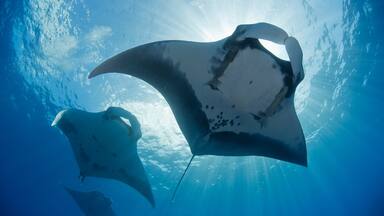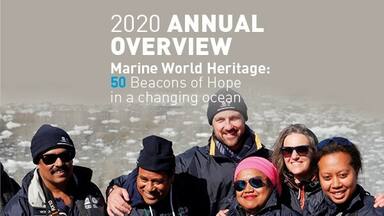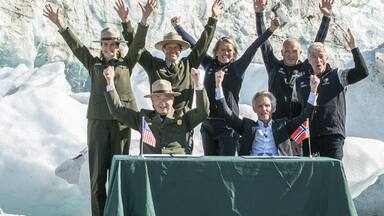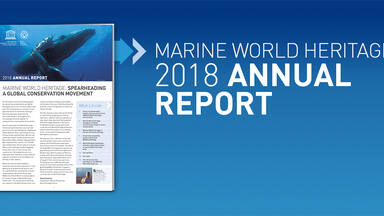West Norwegian Fjords – Geirangerfjord and Nærøyfjord
West Norwegian Fjords – Geirangerfjord and Nærøyfjord
Situated in south-western Norway, north-east of Bergen, Geirangerfjord and Nærøyfjord, set 120 km from one another, are part of the west Norwegian fjord landscape, which stretches from Stavanger in the south to Andalsnes, 500 km to the north-east. The two fjords, among the world’s longest and deepest, are considered as archetypical fjord landscapes and among the most scenically outstanding anywhere. Their exceptional natural beauty is derived from their narrow and steep-sided crystalline rock walls that rise up to 1,400 m from the Norwegian Sea and extend 500 m below sea level. The sheer walls of the fjords have numerous waterfalls while free-flowing rivers cross their deciduous and coniferous forests to glacial lakes, glaciers and rugged mountains. The landscape features a range of supporting natural phenomena, both terrestrial and marine, such as submarine moraines and marine mammals.
Description is available under license CC-BY-SA IGO 3.0
Fjords de l’Ouest de la Norvège – Geirangerfjord et Nærøyfjord
Situés au sud-ouest de la Norvège, au nord-est de Bergen, Geirangerfjord et Nærøyfjord, à 120 km l’un de l’autre, font partie des fjords de l’ouest de la Norvège qui s’étendent de Stavanger au sud jusqu’à Andalsnes, 500 km au nord-est. Les deux fjords, qui sont parmi les plus longs et des plus profonds du monde, sont considérés comme caractéristiques de la géographie des fjords et comme l’un des paysages les plus spectaculaires de la planète. Leur exceptionnelle beauté naturelle provient des parois cristallines, étroites et abruptes, qui s’élèvent jusqu’à 1 400 m au-dessus de la mer et plongent 500 m en dessous. Les parois à pic des fjords abritent de nombreuses cascades tandis que des rivières sauvages coulent à travers des forêts caduques et de conifères vers des lacs glaciaires, des glaciers et les montagnes escarpées. Le paysage contient une variété de phénomènes naturels, tant terrestres que marins, découlant de cet environnement, comme des moraines sous-marines et des mammifères marins. Des vestiges de vieilles fermes de transhumance désormais abandonnées ajoutent un aspect culturel au caractère spectaculaire du lieu et donne une ultime touche humaine au site.
Description is available under license CC-BY-SA IGO 3.0
زقاقان بحريّان غرب النروج، غيرانجرفيورد ونارويفيورد
يقع الزقاقان البحريان، غيرانجرفيورد ونارويفيورد، جنوب غرب النروج، وشمال شرق بيرغن، وتفصل بينهما مسافة 120 كلم. ينتميان إلى الأزقة البحرية الواقعة غرب النروج والممتدّة من ستافانجر جنوبًا حتى أندالسنيس، على بعد 500 كلم إلى الشمال الشرقي. ويتّسم الزقاقان، اللذان يُعدَّان الأطول والأكثر عمقًا عبر العالم، بالخصائص التي تميز جغرافيا الأزقة البحرية ويقدّمان أحد المشاهد الأكثر روعةً على سطح كوكبنا. ينبع جمالهما الطبيعي الاستثنائي من الحواجز الجليدية البلورية الضيقة وشديدة التحدُّر التي يبلغ ارتفاعها 1400م عن سطح البحر والتي تغوص إلى أكثر من 500 متر تحت البحر. كما تأوي قمم الحواجز العديد من الشلالات، في حين تجري الجداول البرية عبر غابات الأشجار النفضية والصنوبريات باتجاه البحيرات الجليدية وألواح الجليد المتراكمة والجبال المنحدرة. يحوي المشهد ظواهرَ طبيعيّة متنوّعة برية وبحرية ناتجة عن هذه البيئة، مثل الجرّافات تحت المائية والثدييات البحرية. وتضفي آثار المزارع القديمة المهجورة جانبًا ثقافيًا على الطابع المشهدي للمكان ولمسة إنسانيّة على الموقع.
source: UNESCO/CPE
Description is available under license CC-BY-SA IGO 3.0
挪威西峡湾-盖朗厄尔峡湾和纳柔依峡湾
盖朗厄尔峡湾和纳柔依峡湾位于挪威西南部,卑尔根的东北部,相互间隔距离120公里,是挪威西部峡湾自南部的斯塔万格市往东北方向绵延500公里至安道尔森尼斯风景的一部分。这两个世界上最狭长的峡湾拥有原始秀美的海湾景观,是风景最为秀丽的地区之一。挪威海上,耸立着1400米高的狭窄而陡峭的水晶岩壁,在海面以下绵延500米,造就了此处独特的自然美景。峡湾中,悬崖峭壁上是数不清的瀑布,自由欢畅的河水穿越落叶和松叶林流入冰湖、冰河和崎岖的山地。一系列的陆地和海洋景观,如海底冰碛和海洋哺乳动物,共同构成了这里突出的景致。
source: UNESCO/CPE
Description is available under license CC-BY-SA IGO 3.0
Фьорды западной Норвегии – Гейрангер-фьорд и Нерёй-фьорд
На юго-западе Норвегии, к северо-востоку от города Берген, располагаются – на расстоянии 120 км друг от друга – два фьорда. Они входят в единую систему норвежских фьордов, которая протягивается от Ставангера на юге до Ондалснеса, что лежит в 500 км к северо-востоку. Эти исключительно живописные фьорды, одни из самых протяженных и глубоких на Земле, признаны классическими примерами такого рода ландшафтов. Своей красотой они обязаны своим крутым склонам, сложенным кристаллическими породами. Берега фьордов возвышаются на водами Норвежского моря до высоты 1400 м, и уходят на глубину до 500 м. С обрывистых берегов фьордов срываются многочисленные водопады, а в их окрестностях, покрытых лиственными и хвойными лесами, можно увидеть ледники, а также ледниковые озера, реки и горы. На территории объекта имеются и другие достопримечательные места, как наземные, так и подводные. Например, это моренные отложения, расположенные ниже уровня моря; также здесь отмечены некоторые морские млекопитающие.
source: UNESCO/CPE
Description is available under license CC-BY-SA IGO 3.0
Fiordos del oeste de Noruega – Geirangerfjord y Nærøyfjord
Distantes entre sí de unos 120 kilómetros, los fiordos de Geirangerfjord y Nærøyfjord están situados en el litoral sudoccidental de Noruega, al nordeste de la ciudad de Bergen, y forman parte del conjunto paisajístico de fiordos que se extiende desde Stavanger hasta Andalsnes, a lo largo de un eje sur-nordeste de 500 kilómetros. El paisaje de la región de estos dos fiordos –que figuran entre los más largos y profundos del mundo– es arquetípico de esta formación geológica y, en el plano estético, es uno de los más notables del mundo en su género. Su excepcional belleza natural se debe a las estrechas y abruptas paredes de roca cristalina que, desde una profundidad de 500 metros, emergen en la superficie del mar y se elevan hasta 1.400 m de altitud. Las paredes a pico albergan numerosas cascadas y ríos impetuosos atraviesan bosques de hoja caduca y coníferas dirigiéndose hacia glaciares, lagos y montañas escarpadas. En el sitio se pueden contemplar fenómenos geológicos como morrenas submarinas y numerosos mamíferos marinos. Al carácter espectacular de la naturaleza vienen a añadirse los vestigios de antiguas alquerías de pastores trashumantes, hoy abandonadas, que ponen una nota humana en el paisaje.
source: UNESCO/CPE
Description is available under license CC-BY-SA IGO 3.0
西ノルウェーフィヨルド群‐ガイランゲルフィヨルドとネーロイフィヨルド
西ノルウェーフィヨルド群は、ノルウェー南西部にあるベルゲンの北東に位置している。なかでも、長さ60㎞のガイランゲルフィヨルドと長さ100㎞のネーロイフィヨルドは、世界で最も長く深いもので、典型的なフィヨルドといえる。フィヨルドは、海面下500mから標高1400mまで立ち上がり、表面は結晶岩で覆われている。岩壁にある数多くの滝は、切り立った崖とともに美しい景観を形作っている。この地域は、海底に堆積するモレーン(氷河で運ばれた氷堆石)や、海生哺乳類の生息も大きな特徴となっている。source: NFUAJ
West-Noorse Fjorden – Geirangerfjord en Nærøyfjord
Geirangerfjord en Nærøyfjord liggen in Zuidwest-Noorwegen ten noordoosten van Bergen. Deze fjorden liggen 120 kilometer van elkaar vandaan en maken deel uit van het West-Noorse fjordlandschap. De twee fjorden, waaronder ’s werelds langste en diepste, worden beschouwd als archetypische fjordlandschappen en ze maken deel uit van de meest opmerkelijke schilderachtige fjorden van de hele wereld. Hun uitzonderlijke natuurlijke schoonheid komt tot uiting in hun smalle en steile rotswanden, die vele watervallen rijk zijn.
Source: unesco.nl
Outstanding Universal Value
Brief synthesis
The starkly dramatic landscapes of Geirangerfjord and Nærøyfjord are exceptional in scale and grandeur in a country of spectacular fjords. Situated in south-western Norway, these fjords are among the world’s longest and deepest, and vary in breadth from just 250 m to 2.5 km wide. Fjord, a word of Norwegian origin, refers to a long, deep inlet of the sea between high cliffs formed by submergence of a glaciated valley. These two West Norwegian fjords are considered to be classic and complementary examples of this phenomenon, a sort of type locality for fjords that still display active geological processes.
Numerous waterfalls and free-flowing rivers, deciduous and coniferous woodlands and forests, glacial lakes, glaciers, rugged mountains and a range of other natural attributes combine towards making Geirangerfjord and Nærøyfjord among the most scenically outstanding landscapes in the world. A serial property covering an area of 122,712 ha, of which 10,746 ha is sea, these two fjords are separated from each other by a distance of 120 km. They form part of the West Norwegian fjord landscape, which stretches 500 km from Stavanger in the south to Åndalsnes in the north-east. Several inhabited villages and valleys are found along the fjords and inside the boundaries, and the landscape is supplemented (although not dominated) by remnants of its human historical past, which adds further interest and value to the property.
Criterion (vii): The Geirangerfjord and Nærøyfjord areas are considered to be among the most scenically outstanding fjord areas on the planet. Their outstanding natural beauty is derived from their narrow and steep-sided crystalline rock walls that rise up to 1400 m direct from the Norwegian Sea and extend 500 m below sea level. Along the sheer walls of the fjords are numerous waterfalls while free-flowing rivers run through deciduous and coniferous forest to glacial lakes, glaciers and rugged mountains. There is a great range of supporting natural phenomena, both terrestrial and marine such as submarine moraines and marine mammals. Remnants of old and now mostly abandoned transhumant farms add a cultural aspect to the dramatic natural landscape that complements and adds human interest to the area.
Criterion (viii): The West Norwegian Fjords are classic, superbly developed fjords, considered as the type locality for fjord landscapes in the world. They are comparable in scale and quality to other existing fjords on the World Heritage List and are distinguished by the climate and geological setting. The property displays a full range of the inner segments of two of the world’s longest and deepest fjords, and provides well-developed examples of young, active glaciation during the Pleistocene ice age. The ice- and wave-polished surfaces of the steep fjord sides provide superbly exposed and continuous three-dimensional sections through the bedrock. The record of the postglacial isostatic rebound of the crust and its geomorphic expression in the fjord landscape are significant, and represent key areas for the scientific study of slope instability and the resulting geohazards.
Integrity
The two fjord areas include all features that typically characterise a fjord landscape and its geological evolution. These include deep rock basins reaching depths far below sea level, prominent rock thresholds, high and steep cliffs, slide scars and avalanche deposits, moraines, till deposits, hanging valleys, so-called fish-hook or agnor valleys (formed by river capture), glaciers, rivers, waterfalls and surrounding mountain and catchment areas. Each fjord has a different morphology and geology and displays a different range of geomorphological features. Taken together, the Nærøyfjord and Geirangerfjord areas provide most of the features in their natural relationship that could be expected of a fjord landscape and its geological evolution. The boundaries of the serial property are appropriately defined to protect the geological features and the areas required to maintain the scenic qualities of the property. Legislation, staffing, budget and institutional structures in place are adequate to ensure its integrity.
Of the 200 fjords along the west coast of Norway, Nærøyfjord and Geirangerfjord are the least affected by human activity such as hydroelectric dams and infrastructure. Peridotite is currently quarried outside, but close to the Geirangerfjord component of the property and plans exists for another quarry nearby. These impacts are localized, and restoration will take place when extraction ceases. Underground extraction of anorthosite takes place in the Nærøyfjord area, and this may expand in the future. Though not directly adjacent to the fjord itself, the plant has a visual impact from the road in the Nærøydalen valley.
Protection and management requirements
The majority of the property is protected as an IUCN Category V “Protected Landscape” and several small areas within this are Category I “Strict Nature Reserve”. The legislative regulations embodied in the Norwegian Nature Diversity Act provide long-term protection for the full range of natural values. While private lands make up 85% of the property, inhabited parts are carefully controlled under the Planning and Building Act and mechanisms such as County, Municipal and Local Development Plans.
An effective management system includes advisory committees and a management council that meets regularly to facilitate the necessary management cooperation and co-ordination. A “Declaration of Intent” signed by all the relevant national agencies and the Borough Councils, County Councils and County Governors outlines the cooperative measures and “guarantees that the values in the area will endure.”
A comprehensive management plan addresses management objectives and includes guidelines for activities to preserve the Outstanding Universal Value in a long-term perspective. The existing monitoring system needs to be further developed.
Tourism pressures are intense in both fjords, but impacts are limited as most visitors access the property on cruise ships during a short visitor season. Adequate tourism management plans are an important tool for the long-term conservation of the property’s Outstanding Universal Value.
Mining and underground quarrying is a concern, and any expansion of these activities will not be permitted without an environmental impact assessment. This would ensure that any potential impact, including the export of the mined material and the need for related infrastructure, would not affect the property’s Outstanding Universal Value.
Geohazards are a concern for inhabited areas and existing infrastructure within the property. If more measures to protect people’s lives are to be implemented, detailed environmental impact assessments will need to be performed to ensure solutions and measures that will be compatible with the property’s Outstanding Universal Value. Risk-preparedness plans integrated in the overall management plan are essential for this property.
Links
-
World Heritage sites in Norway (in English, Norwegian Bokmål, and Sami)
-
Geiranger-Herdalen (in Norwegian only)
-
West Norwegian Fjords (in English and Norwegian)
-
Nærøyfjorden verneområdestyre (in Norwegian only)
-
Norwegian Fjord Centre in Geiranger (in English and Norwegian)
-
Nærøyfjord area (in English, Norwegian, and German)
-
Protectedplanet.net








